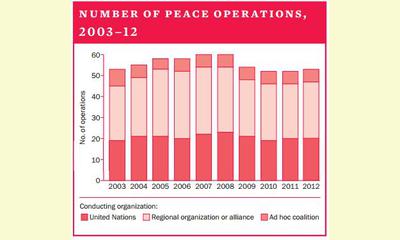|
|
Peace Operations and Conflict Management
un article par SIPRI Yearbook (excerpt)
A total of 53 peace operations were conducted in
2012, one more than in 2011 but still the third
lowest number in the period 2003–12. The number
of personnel serving with multilateral peace
operations worldwide fell by more than 10 per cent
in 2012—down by 28 487 to 233 642—as the slight
reduction in deployed personnel that started in
2011 gathered pace. The large drop was due to the
withdrawal of troops from the International
Security Assistance Force (ISAF) in Afghanistan.
However, the reductions followed almost a decade
of rapid expansion, and the total for deployments
was still the third highest since 2003.

click on photo to enlarge
Excluding ISAF, deployments increased by 847
personnel. This is the first increase in non-ISAF
personnel numbers ISAF since 2008. The small
increase in the number of operations between 2011
and 2012 suggests that the trend, which has been
downwards since 2009, may be beginning to stabilize.
Austerity led some states to be more critical of
spending on peace operations and to increase
budget constraints on missions in 2012. The
United Nations Security Council increasingly
imposed benchmarks and indicators to evaluate
existing UN missions’ effectiveness and
efficiency, and linked these to future mandate
renewals.
Doubts about the capacity and will for protection
of civilians (POC) in peace operations were
reinforced in 2012 by the perceived failures of UN
operations in Côte d’Ivoire, the Democratic
Republic of the Congo (DRC) and South Sudan.
However, the problem may lie more in unrealistic
mandates and expectations. Divisions in the
international community were also visible in the
response to a military coup in Guinea-Bissau,
where the African Union (AU), the European Union
(EU) and the UN refused to recognize a
transitional government set up through a
controversial process mediated by the Economic
Community of West African States (ECOWAS).
Despite these doubts, divisions and budget
constraints, there is no reason to believe that
the number of operations will decrease
significantly in the near future, and the number
of troops deployed outside Afghanistan is in fact
likely to grow. How deep the dip in total
personnel deployed will be after the drawdown of
ISAF and how diffuse the future picture depend on
three factors: the depth of future budget cuts in
the West and the extent to which they are allowed
to affect the military and peacekeeping capacity;
the number of troops that are eventually deployed
in Mali, the broader Sahel and potentially Syria;
and the extent to which countries are willing to
put the responsibility to protect (R2P) and POC
into practice rather than simply express outrage
over the lack of responsiveness. . .
(Click here for a Spanish version of this article) or here for a French version)
|








|
DISCUSSION
Question(s) liée(s) à cet article:
Can military peacekeeping operations promote a culture of peace?,
* * * * *
Commentaire le plus récent:
The answer this question provided by UNESCO in 1992 was "no." The culture of peace program at UNESCO was launched as an alternative to peacekeeping operations, because it was considered that soldiers cannot bring a culture of peace. Is there any reason to think that this has changed in the intervening 20 years?

|
|









